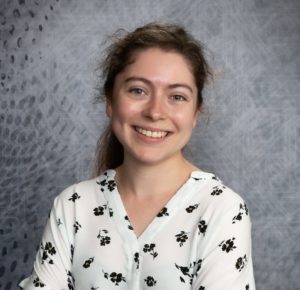Current Students Studying at The Center for Ergonomics
|
Ph.D. Students
|
 Apodaca, Brandon Apodaca, Brandon |
- Degree Program: Ph.D., Expected graduation: 2026
- Area of Interest: Supervised Inspection Motion and Path Planning for Robotic Free-Flyer Space Inspections
- Advisor(s): Prof. Leia Stirling
|
 Baez, Hannah Baez, Hannah |
- Degree Program: Ph.D., Expected graduation: 2026
- Area of Interest: Human-Robot Interaction
- Advisor(s): Prof. Nadine Sarter, Prof. Brent Gillespie
- Desired Employment: HRI/Search and Rescue Robotics Industry
|
 Bhat, Shreyas Bhat, Shreyas |
- Degree Program: Ph.D.
- Area of Interest: Human-robot teaming, quantitative modeling of trust, and reward learning
- Advisor(s): Prof. X. Jessie Yang, Prof. Cong Shi
|
| Chung, Hyesun |
- Degree Program: Ph.D.
- Area of Interest: Human-automation interaction, human-centered design, and accessibility
- Advisor(s): Prof. X. Jessie Yang
|
 Guo, Yaohui Guo, Yaohui |
- Degree Program: Ph.D.
- Area of Interest: Human-AI/Robot Interaction, Sequential Decision Making, Linear Bandits
- Advisor(s): Prof. X. Jessie Yang, Prof. Cong Shi
|
 Han, Doowon Han, Doowon |
- Degree Program: Ph.D.
- Area of Interest: Human-machine interaction, user interface/user experience and trust in automation.
- Advisor(s): Prof. X. Jessie Yang
|
 Hannan, Jacqueline Hannan, Jacqueline |
- Degree Program: Ph.D., Expected graduation: 2025
- Area of Interest: Jacqueline is a graduate student in the Industrial and Operations Engineering department at the University of Michigan. Her current research interests include applying human factors concepts to the healthcare field to improve overall patient care. She is also interested in the use of wearable technology for health applications. Prior to studying at the University of Michigan, Jacqueline received her B.S. in biomedical engineering from the University at Buffalo.
- Advisor(s): Prof. Leia Stirling
- Desired Employment: Industry
|
 Jeanniton, Caleb Jeanniton, Caleb |
- Degree Program: Ph.D., Expected graduation: 2026
- Area of Interest: Human-machine interaction
- Advisor(s): Prof. Leia Stirling
|

Kathuria, Tribhi |
- Degree Program: Ph.D., Expected graduation: 2024
- Area of Interest: Tribhi is a graduate student in Robotics at the University of Michigan, Ann Arbor working jointly at the Interaction & Collaboration Research Lab (ICRL) and the Computational Autonomy and Robotics Laboratory (CURLY). Her research interest lies in studying Motion Planning and Control techniques for autonomous systems in a way that can be deployed in the real world. Currently she is working on developing algorithms for a tour guide robot that can understand and assist visitors inside a museum autonomously. She completed an undergraduate degree in Instrumentation and Control Engineering from Delhi University, followed by a masters degree in Robotics at University of Michigan.
- Advisor(s):Prof. Maani Ghaffari Jadidi, Prof. X. Jessie Yang
- Desired Employment:Academia, Industry
|

Kim, Jinyong |
- Degree Program: Ph.D.
- Area of Interest: My research focuses on Human-Computer Interaction (HCI), specifically to enhance human trust when using automation. My future goal is to conduct human factors research to improve HCI for people with disabilities and the aging population.
- Advisor(s): Prof. X. Jessie Yang
|
 Larson, Hannah Larson, Hannah |
- Degree Program: Ph.D., Expected graduation: 2024
- Area of Interest: Human-robot Interaction in autonomous controls with a focus in space applications
- Advisor(s): Prof. Leia Stirling
- Desired Employment: Undecided
|
| Moshin, Nourin |
- Degree Program: Ph.D., Expected graduation: 2025
- Area of Interest: Fatigue, Neuroergonomics
- Advisor(s): Prof. Oshin Tyagi
|
| Nigrelli, Emma |
- Degree Program: Ph.D., Expected graduation: 2028
- Area of Interest: Biomechanics and wearable technology
- Advisor(s): Prof. Leia Stirling
|
 Peng, Xiangyu Peng, Xiangyu |
- Degree Program: Ph.D., Expected graduation:
- Area of Interest: Xiangyu’s main research interest lies in human-robot interaction and exoskeleton controller development. His current project focuses on the understanding of people’s perception towards exoskeleton control parameters, which could inform the controller design in the future to minimize perceived interaction forces between human and exoskeleton.
- Advisor(s): Prof. Leia Stirling
- Desired Employment: Academia, Industry
|
 Schuler, Patrik Schuler, Patrik |
- Degree Program: Ph.D., Expected graduation: 2023
- Area of Interest: Patrik’s current research interests focus on Human Factors and Physical Ergonomics, specifically with inclusive and accessible design. He received his undergraduate degree in Industrial Engineering at Clemson University. Prior to college, he served 5 years as a radio repairman in the United States Marine Corps. From that experience, he became motivated in facilitating functional independence for people with disabilities. At the University of Michigan, he is implementing inclusive design principals through Autonomous Vehicles.
- Advisor(s): Prof. Jessie Yang
- Desired Employment: Academia, Industry
|
| Seong, Matthew |
- Degree Program: Ph.D., Expected graduation: 2027
- Area of Interest: Mind/motor adaptation, Neuroergonomics
- Advisor(s): Prof. Oshin Tyagi
|
 Swilley, Jakob Swilley, Jakob |
- Degree Program: Ph.D.
- Area of Interest: Human Factors Engineering for Spaceflight applications
- Advisor(s): Prof. Leia Stirling
|
 Tang, Jianyang (Joe) Tang, Jianyang (Joe) |
- Degree Program: Ph.D., Expected graduation: 2026
- Area of Interest: Robotics
- Advisor(s): Prof. Leia Stirling
|
| Wang, Yuanchen |
- Degree Program: Ph.D.
- Area of Interest: Human-autonomy and human-robot interactions
- Advisor(s): Prof. X. Jessie Yang
|
| Williams, Connor |
- Degree Program: Ph.D., Expected graduation: 2027
- Area of Interest: Human-Robot Interaction with Exoskeleton Systems
- Advisor(s): Prof. Leia Stirling
|
| Wu, Man I (Maggie) |
- Degree Program: Ph.D., Expected graduation: 2024
- Area of Interest: Lower-body exoskeletons, human-robot interaction, robotics
- Advisor(s): Prof. Leia Stirling
|
 Zamudio, Jennifer Zamudio, Jennifer |
- Degree Program: Ph.D.
- Area of Interest: My research focuses on human factors engineering applications in healthcare, with a specific interest in enhancing team interactions, cognitive ergonomics, and well-being among healthcare professionals within stressful/high workload environments (e.g., robotic surgery, trauma care).
- Advisor(s): Prof. X. Jessie Yang
|
| Zhang, Qiaoning |
- Degree Program: Ph.D.
- Area of Interest: Human-Computer Interaction, Human Centered Design, UX Research, Self-Driving Vehicles
- Advisor(s): Prof. X. Jessie Yang
|

 Apodaca, Brandon
Apodaca, Brandon Baez, Hannah
Baez, Hannah Bhat, Shreyas
Bhat, Shreyas Guo, Yaohui
Guo, Yaohui Han, Doowon
Han, Doowon Hannan, Jacqueline
Hannan, Jacqueline Jeanniton, Caleb
Jeanniton, Caleb

 Larson, Hannah
Larson, Hannah Peng, Xiangyu
Peng, Xiangyu
 Swilley, Jakob
Swilley, Jakob Tang, Jianyang (Joe)
Tang, Jianyang (Joe)  Zamudio, Jennifer
Zamudio, Jennifer